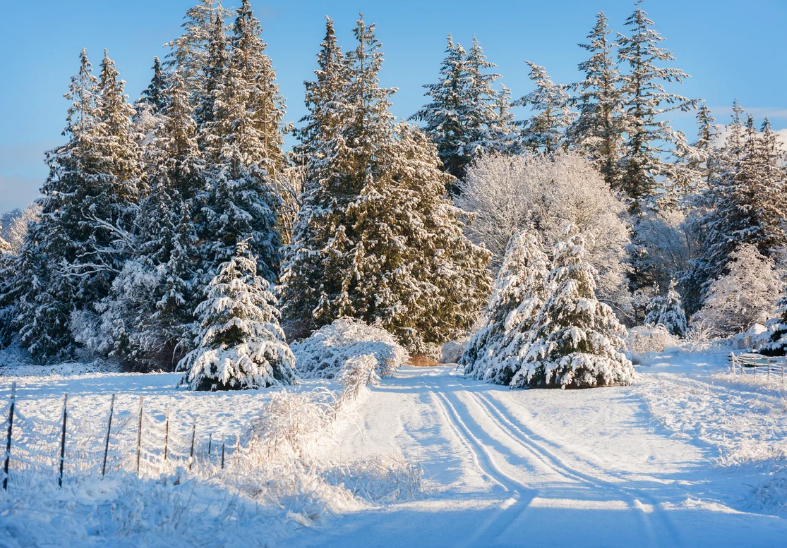Context
According to a new study by scientists from Dartmouth College in New Hampshire, United States (US), the snowpacks that form due to the accumulation of snow in river basins of the northern hemisphere during the winter season have shrunk in size in the past 40 years due to human-induced climate change.
Report Findings
- The study has been published in the journal Nature on January 10, 2024. The decrease in snowpacks is going to accelerate with further warming.
- The study analysed 169 river basins and found declining trends of snow in 82 of them.
- The scientists have attributed 31 of these to warming of the planet due to the release of greenhouse gases into the atmosphere from human activities.
- The amount of accumulated snow is measured in snow water equivalent (SWE), which is the amount of water a snowpack contains.
Relationship between snow and global temperature highly non-linear in nature:
- The study also found that the relationship between snow and increase in global temperatures was highly non-linear in nature.
- When winter temperatures exceed -8 degrees Celsius (°C), snow becomes marginally more sensitive to 1°C of warming.
- The scientists surmise that it is because of the non linearity that widespread snow loss would occur with further warming of the planet.
- This becomes a concern as the Earth is currently 1.1°C warmer than the pre-industrial period.
- The warming is much higher in those regions of the northern hemisphere which get significant amounts of snowfall (such as Europe).
European Union’s report:
- The European Union’s (EU) Copernicus Climate Change Service (C3S) declared on January 9 that 2023 was the warmest year on record at 1.48°C warmer than the pre-industrial average.
- A report by the World Meteorological Organisation (WMO) and the C3S from 2023 found that Europe is now 2.3°C warmer than in the pre-industrial period.
- The report finds that the snowpacks in most of the European river basins are faring much worse than the rest of the world.
- In much of western, central and northern Europe, the SWE in March (which is the end of the snowfall season for the northern hemisphere) has decreased by 10-20 per cent per decade between 1981 and 2020.
- This data is from gridded snow products which are developed from satellite imagery, existing ground level observations and rainfall radars.
Decline in the Hindu Kush Himalayan (HKH) region
- The rate of warming is also much faster in the Hindu Kush Himalayan (HKH) region, which is home to around 54,000 glaciers and needs to be replenished to an extent by snowfall every winter.
- The current study found that in the Ganga and Indus River basins, the SWE has decreased by 1-3 percent in the last 40 years.
- This data comes with some caveats as there is a dearth of ground level observations from these two river basins and the HKH region, which feeds the Ganga and Indus.
- The snowfall in 2023 has been especially low in the entire HKH region, with many mountain tops devoid of any snow.
Reason for decline:
- Many observers are calling it a no snow year for the region. This has mainly happened because of a lack of intense western disturbances and their southward dip in the region in the current winter season of 2023-2024.
- According to the International Centre for Integrated Mountain Development or Icimod, the HKH region has warmed at a rate of 0.2 degree Celsius per decade in the last 50 years.
Importance of HKH:
- These glaciers are sources for mountains springs, rivulets and ultimately mighty rivers such as the Indus and the Ganga which are, in turn, a source of life and livelihoods for millions of people downstream.
Impact of decline
Water insecurity: The decline in snow continues and becomes more drastic with increasing temperatures, like has happened in 2023, it could lead to massive food and water insecurity for millions of people.
- Ninety per cent of the global population lives in the Northern Hemisphere, above the Equator.
Food insecurity: Reduced water availability and changes in growing seasons can negatively impact agricultural yields, leading to food insecurity and price hikes.
- In 2024, people are already worried for their agricultural and horticultural yields in states/Union Territories like Jammu and Kashmir, Himachal Pradesh and Uttarakhand.
Ecosystem disruption: Changes in snowmelt patterns can disrupt ecosystems, impacting plant and animal life. For example, earlier snowmelt can disrupt breeding cycles of snow-dependent species.
Sea level rise: Melting glaciers and snowpacks contribute to sea level rise, increasing coastal flooding risks and displacing millions of people.
Concept of Snow water equivalent (SWE)
For SWE measurements, scientists take into account both the amount of snow and the run off it generates.
It is challenging to measure SWE. This is because the amount of snow produced by one inch (2.54 centimetres) of rainfall depends on how cold the air is in that particular region, according to the US Department of Agriculture.
- One inch of rain can produce 50 inches (127 centimetres) of snow or more.
- The amount of water in a snowpack depends on the type of storm that has brought the snow.
- The colder the storm, the greater would be the accumulation of snow.

